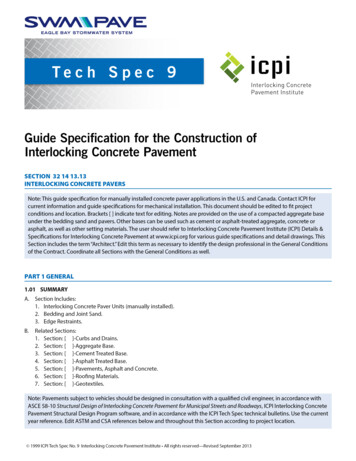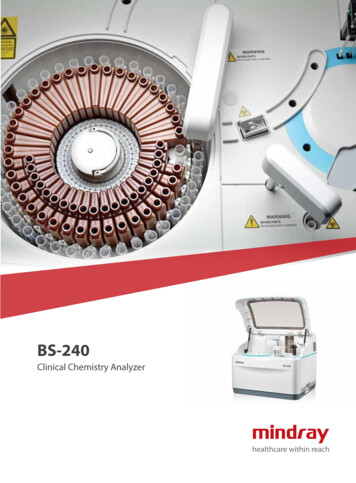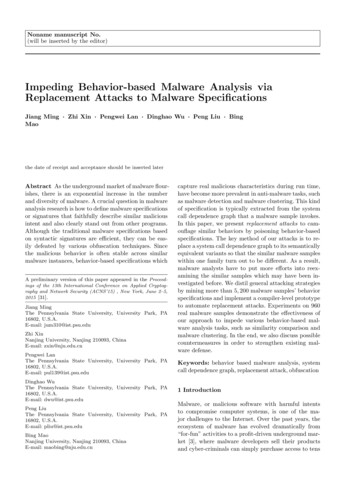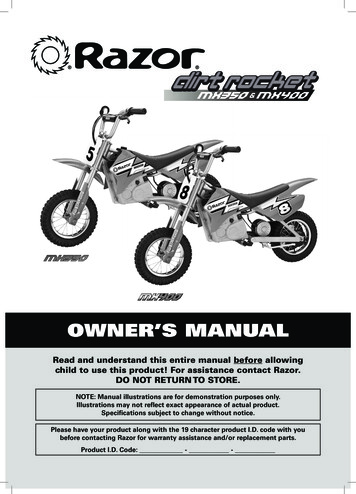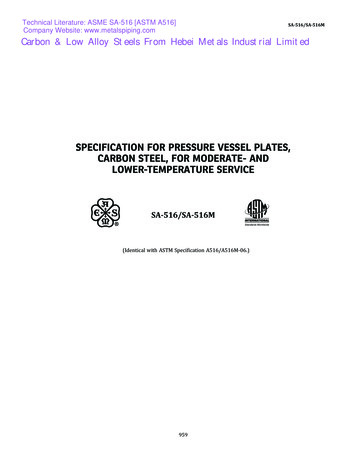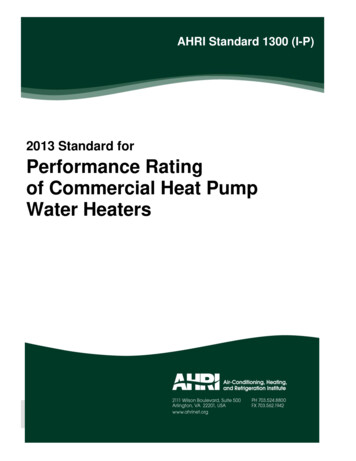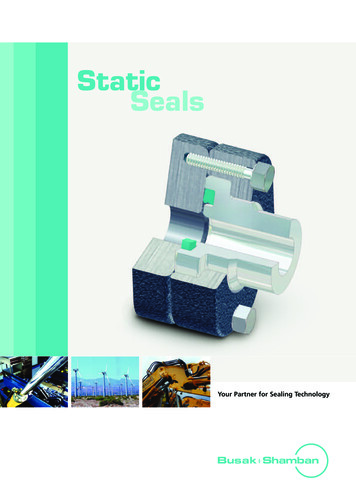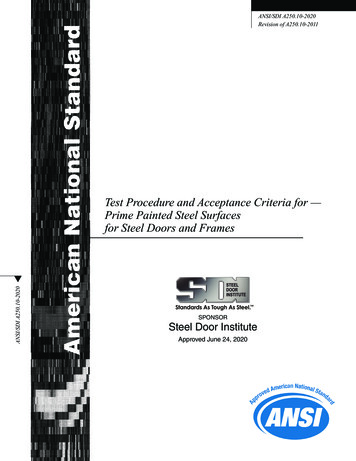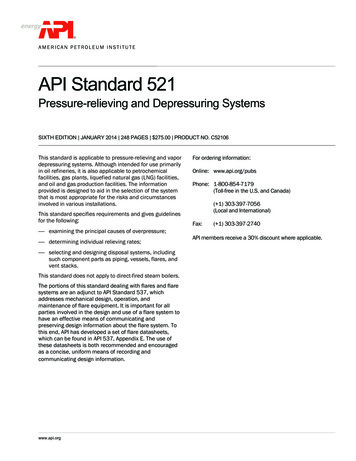
Transcription
Standard Specificationsfor Steel and Composite Structures【 First Edition 】I General Provision, II Structural Planning, III DesignDecember, 2009Japan Society of Civil Engineers
This document is an English translation of the original Japanese text. JSCE assumes no responsibilityor liability for errors or inaccuracies that may occur due to use or application of the information providedherein.
ForewordJapan Society of Civil Engineers (JSCE) was established as an incorporated association in 1914entrusted with the mission to contribute to the advancement of scientific culture by promoting the fieldof civil engineering and the expansion of civil engineering activities. Committee on Steel Structuresof JSCE was reorganized in 1971 aiming to research and investigate steel materials, steel structuresand composite structures, and to contribute to the progress of science and technology in a field of civilengineering. Since its establishment, the committee has organized a lot of subcommittees and they haveproduced a lot of outcomes related to steel materials, steel structures and their technological standards.The internationalization of technological standards and the performance-based design are paid toattention in recent years. In the performance-based design, the improvement of transparency and accountability, the reductions of cost and negative environmental impact, and securing the quality and theperformance, etc. are basic requirements. The committee resolved to make the ”Standard Specificationfor Steel and Composite Structures” including hot technologies in 2004 as the JSCE specification doesnot fall behind the world trends. The specifications consist of 6 volumes. ”General provision”, ”BasicPlanning” and ”Design” were published in 2007, ”Seismic design” was issued in 2008, and ”Construction”was also come out in 2009 in Japanese. ”Maintenance” will be also appeared soon. These are the firststandards by the committee on steel structures made as the performance-based design format and thelimit state design method. I think that it is very meaningful to have completed the specifications usingthe performance-based design format at this time when a technological standard of western countriesaims at the world standard.It is expected that the contents of the specifications does not reveal only a state of the latest technologyof the steel structure but also the direction of activities that the committee should aim. This Englishversion was translated from the Japanese originals of ”General provision”, ”Basic Planning” and ”Design”of ”Standard Specification for Steel and Composite Structures”. I hope that the specifications will beuseful and helpful for the design of steel and composite structures in the world.Finally, warm acknowledgment is expressed to all of the members of the Sub-Committee on StandardSpecification for Steel and Composite Structures and the Committee on Steel Structures for their effortsto preparation of the specifications and their invariable suggestions to the contents of the specifications.December, 2009MORI TakeshiChairman, Committee on Steel StructuresJapan Society of Civil Engineers
PrefaceIn 1987, the Committee on Steel Structures published two design codes based on Allowable StressDesign Method. They are ”Design Code for Steel Structures PART-A: Structures in general” and ”DesignCode for Steel Structures PART-B: Composite structures”. The newly revised above versions based onLimit State Design Method were published in 1997.In 2000, the committee on Steel Structures organized a sub-committee for investigation of theperformance-based design method. Its activity was to prepare and recommend a new design format,performance-based design for steel structures, coping with globalization. The report entitled ”Towardsperformance-based design method for steel structures” was published in 2003. The committee on SteelStructures has recognized that the basic design format for steel structures of the next generation wasestablished. After the publication of the above report, the committee on Steel Structures organized thesub-committee on Standard Specifications for Steel and Composite Structures in 2004. Its role is notonly to incorporate latest research fruits but to publish an innovative and competitive performance-basedlimit state design method for steel and steel-concrete composite structures of the next generation.It consists of 6 volumes namely ”General provision”, ”Basic Planning”, ”Design”, ”Seismic design”,”Construction” and ”Maintenance”. The three volumes including ”General provision”, ”Basic Planning”and ”Design”, were issued in 2007. It is based on the performance-based limit state design method,and is the first time publication for the design of steel and composite structures in civil steel structuralengineering field in Japan. The volume of ”Design” deals with not only steel structures but also concreteslabs and steel-concrete composite girders for composite girder bridge design. Many of the provisions forsteel structures are from those in ”Design Code for Steel Structures PART A: Structures in General”published in 1997. Even though we seldom design composite girder bridges in Japan, hybrid structuresincluding composite girders have been recognized to be worldwide competitive alternatives. For globalcompetition, the provision for composite girders is inevitable. In addition to introducing the designformulae by AASHTO LRFD or EC given in PART-B, the original formulae developed by Japaneseyoung researchers were incorporated. This is also the first time action in Japan after the publication ofPART-B in 1997. I hope the revising work continues towards global-top design of the next generation.The preparation of an English version including three volumes started in 2007 by many of code writerson a voluntary basis. First of all, I would like to express my sincere gratitude to all writers for theirdevoted contribution. I also have to express my sincere gratitude to JSCE Research Fund, Committeeon ISO Affairs in Civil Engineering, Prof. Yoda of Waseda University and Prof. Nogami of TokyoMetropolitan University for their financial supports on publication of the English version. I would liketo give my sincere thanks to all members of the committee on Steel Structures and of the sub-committeeon Standard Specifications for Steel and Composite Structures for their valuable comments.December, 2009NAGAI MasatsuguChairman, Subcommittee on Standard Specifications for Steel and Composite StructuresCommittee on Steel StructuresJapan Society of Civil Engineers
Committee for Steel structuresAdviserChairmanVice-chairmanSecretary generalMemberIkuma M.,Echigo S.,Okamoto T.,Kainuma S.,Kiyomiya O.,Sakano M.,Sumi M.,Nagai M.,Nishikawa K.,Fukada S., Honma K.,Murakoshi J.,Yamamoto H.,: Abe H.,Sakai H.,: Mori T.: Takagi S.: Sasaki Y.Ito M.,Nishimura N.,Igarashi H.,Oga M.,Ogawa A.,Kasuga A., Sakai S.,Shito K., Tachibana Y.,Nakazawa M., Nogami K.,Fujii K.,Maekawa K.,Mori K.,Yukawa M.,Usami T.,Watanabe E.Ichikawa A.,Ogaki K.,Okui Y.,Kamihigashi Y.,Keira K., Sugimoto I.,Tatsumit M.,Nakajima A.,Nozawa S.,Fujino Y.,Masuda N., Yaginuma Y.,Yoda T.Kato M.,Kuranishi S.,Iwasaki E.,Ota K.,Oshita S., Kaneko S.Goto Y.,Sugiura K., Tateishi K.,Naganuma T.,Hayashikawa T.,Fujiwara H.,Miki C.,Yamaguchi E.,Iwanami M.,Otori Y.,Ono K.,KItada T.,Konishi T.,Sugiyama T.,Tanaka M.,Nara S.,Hirabayashi Y.,Hotta T.,Murakami S., Yamaguchi T., :OrganizerSub-committee for Standard Specificationsfor Steel and Composite StructuresChairmanSecretary generalMemberIkuma M., Ichikawa A.,Ogaya S.,Sakano M.,Tateishi K.,Nozawa S.,Miki C.,Yokota H.,:Nagai M.:Yamaguchi E.Ito N.,Inokuma Y.,Okui Y.,Sugiura K.,Tamaoki T.,Hayashikawa T., Murakoshi J.,Watanabe E.,Suzuki E.,Iwakuma T.,Ono K., Sugiyama T.,Nara S.,Hino S., Mori T.,Park Y.S.,Hakamada F., Usami T.,Kitada T., Sumi M., Nishimura N.,Hujino Y.,Yamamoto H.,Kyung K.S.,Abe M.,Okamoto T.,Goto Y.,Takagi S., Nogami K.,Hotta T., Yoda T.,Ha D.H. :Organizer* :Observer
Sub-committee for Standard Specificationsfor Steel and Composite StructuresGeneral Provision WGChairman:Sugiyama T.MemberIkeda M.,Nogami K.,Ichikawa A.,Mori T.,Usami T.,Yamaguchi E.Okui Y.,Nishimura N.,Structural Planning WGChairman:Ichikawa A.MemberIkeda H.,Katsuchi H.,Morino M., Ikeda M.,Sugiyama T.,Yamamoto H.,Ito A.,Takagi S.,Yokota H.Ogaki K.,Hosaka T.,Ono K.,Hota T.,old member : Inokuma Y. :OrganizerDesign WGChairmanSecretary generalMember Akimoto R., Ishikawa T.,Ogaki K., Kitahara T., Sugiyama T.,Nakasu K., Huruya N., Murakami S., Yoneyama H.:Yoda T.:Nogami K.Arima N., Uchida D., Okada J.,Kumagai Y., Tanaka K., Nakahara T.,Maeda K.,Yanagawa H., Iura M., Ikariyama H., Ikeda M., Urata M., Ota M., Ota K., Okui Y., Kainuma S., Kawabata A.,Sato N., Tanaka C., Nakamura S., Miura Y., Yabuno M., Saito N., Suzuki S., Tsuruta H., Nakazawa M., Nakamura S., Nagai M., Minami K., Murakami M., Yamaguchi E., Yamaguchi T.,old organizer : Ikeda D. :Organizer
Sub-committee for Standard Specificationsfor Steel and Composite StructuresWriting author of Design WGChapter 1, 2 Sugiyama T. ,Akimoto R. ,Chapter 3, 5 Nakamura S. , Okada J. , Chapter 4, 6Tanaka K.,Nakazawa M.,Urata M. ,Chapter 8 Kainuma S. ,Minami K. ,Sugiyama T. , Chapter 11 Saitou N. ,Miura Y.,Yabuno M. ,Murakami M. Yamaguchi T. ,Chapter 14Chapter 15 Murakami S. ,Akimoto R., Iura M.,Saitou N.,Murakami S.,Yamaguchi T.Ota M.,Yoneyama H.Tsuruta H.Akimoto R. , Kitahara T., Chapter 13Huruya N. Yamaguchi E. , Ishikawa T. , Kitahara T. ,Chapter 10, 12Okui Y.,Urata S. Chapter 7Chapter 9Ikeda M.,Iura M.,Miura Y. ,Yoneyama H.Ishikawa T.,Nakamura S.,Tanaka K.,Minami K. Murakami M. , Kitahara T.,Nakazawa M.,Nakamura S. Kawabata M. ,Ikariyama H. , Nakamura S., Ota K., Uchida D.,Tanaka C.,Nakahara T., Suzuki S.,Akimoto R. Okui Y. ,Ota M. , Okada J., Huruya N., Yabuno M., Nagai M., Nakamura S., Nogami K. :Chief:Organizer :Member who translated into English
Volume IGeneral Principles
Standard Specifications for Steel and Composite Structures【 General Principles 】ContentsChapter 1 General . . . . . . . . . . . . . . . . . . . . . . . . . . . . . . . . . . . . . . . . . . . . . . . . . . . . . . . . . . . . . . . . . . . . . . . . . . 11.1 Fundamental Philosophy . . . . . . . . . . . . . . . . . . . . . . . . . . . . . . . . . . . . . . . . . . . . . . . . . . . . . . . . . . . . . . . . . 11.2 Composition . . . . . . . . . . . . . . . . . . . . . . . . . . . . . . . . . . . . . . . . . . . . . . . . . . . . . . . . . . . . . . . . . . . . . . . . . . . . . 11.3 Scope. . . . . . . . . . . . . . . . . . . . . . . . . . . . . . . . . . . . . . . . . . . . . . . . . . . . . . . . . . . . . . . . . . . . . . . . . . . . . . . .21.4 Documents concerning Design, Construction and Maintenance . . . . . . . . . . . . . . . . . . . . . . . . . . . . 31.5 Meanings of Descriptive Words and Clauses in These Specifications . . . . . . . . . . . . . . . . . . . . . . . 41.6 Ability and Responsibility of Engineers . . . . . . . . . . . . . . . . . . . . . . . . . . . . . . . . . . . . . . . . . . . . . . . . . . . 41.7 Check at Structural Plan and Design Stages . . . . . . . . . . . . . . . . . . . . . . . . . . . . . . . . . . . . . . . . . . . . . . 51.8 Terms and Definitions . . . . . . . . . . . . . . . . . . . . . . . . . . . . . . . . . . . . . . . . . . . . . . . . . . . . . . . . . . . . . . . . . . . . 5Chapter 2 Basis for Structural Planning, Design, Construction and Maintenance . . . 102.1 Purpose of Structural Planning, Design, Construction, and Maintenance . . . . . . . . . . . . . . . . . 102.2 Verification of Performance . . . . . . . . . . . . . . . . . . . . . . . . . . . . . . . . . . . . . . . . . . . . . . . . . . . . . . . . . . . . . . 112.3 Performance Level and Importance of Structure . . . . . . . . . . . . . . . . . . . . . . . . . . . . . . . . . . . . . . . . . 14( 1)
1Chapter 1 General1.1 Fundamental PhilosophyThe fundamental philosophy of these specifications is that performance verification methodsshall be applied to all of structural plan, design, construction, and maintenance of steel andcomposite structures and engineers’ ethics shall be observed at every stage.【 commentary 】These Standard Specifications for Steel and Composite Structures are based on performance verification methods in which the required performance of a structure is specified first and then actual performance is verified at all stages: structural planning, design, construction and maintenance.Consequently, the fundamental philosophy behind these specification is that performance verificationmethods should be applied at the structural planning, design, construction, and maintenance stages ofsteel and composite structures, while fully observing engineering ethics at every stage. Within thesespecifications, the actual articles relating to the observance of engineering ethics can be considered the1 accountability for structural planning, design, construction, and maintenance work; 2following: traceability of reasons for decision-making after the fact; and 3 compliance. Currently, some performance requirements of structures are not explicitly verified, so some parts of the specifications are notfully complete.1.2 CompositionThese specifications are composed of six volumes; that is, General principles volume, structuralplan one, design one, seismic design one, construction one, and maintenance one.【 commentary 】The six volumes of these specifications apply to the structural planning, design, construction, andmaintenance of structures.A structure’s various performance requirements should be upheld throughout the design workinglife of the structure and this must be confirmed. It is necessary to succeed to the information relatingto ”performance requirements and methods of achieving them” and/or ”purpose and achievementmethod” at each stage of structural planning, design, construction, and operation and maintenanceto the next stage certainly. That is, all stages should correlated with each other closely as shownin Fig.C1.2.1. At the structural planning and design stages, assumptions are made about the typeand size of structure and then the performance level required of this assumed structure is verified.Immediately after construction is completed, it should be checked whether this required performancelevel is satisfied or not. At the maintenance stage, the performance level of the in-service structureis estimated based on information collected through inspections, because the performance level ofa structure generally decreases over time. Based on this estimate, a judgment as to the structuralsoundness of the structure - that is, whether the performance level of the structure is equivalent to orexceeds the a priori determined required performance - is made and the result is later fed back intothe operation and maintenance plan.
2Standard Specifications for Steel and Composite Structures [General principles]As noted above, checking and confirmation of the performance level of a structure continues throughall stages of structural planning, design, construction, and operation and maintenance. Thus, thesespecifications include five volumes corresponding to structural planning, design, construction, andmaintenance of structures, respectively. It should be noted that design is separated into a Designvolume and a Seismic Design volume. This is because it is generally recognized that design philosophyand verification techniques relating to seismic design are different from those of other areas of structuraldesign and that a separate explanation of seismic design may be convenient for design engineers.Level of performanceMarginal level of Performance(use rectionYesReview ofmaintenanc(check)(check and measures)PassingCheck resultForecast ofConfirmation ofperformanceNoMeasures(repair andPerformance of structure during its life cycle1.3 ScopeThese specifications shall be applied to the structural plan, design, construction, and maintenance of steel structures, composite girders, and composite columns (described as ”steel andcomposite structures” hereafter).【 commentary 】These specifications apply to the structural planning, design, construction, and maintenance of steelstructures, composite girders, and composite columns filled with concrete. Composite columns aretreated explicitly only in the Seismic Design volume. The structures considered in these specificationsare general steel structures in which structure of the main members consists of steel and compositegirders and columns composed of both steel and concrete. As for composite girders, references [JSCE2002a] and [JSCE 2002b] may be referred to instead of these specifications.Highway and railroad bridges are the main focus of these specifications, although port and harborstructures, river structures, and electric power facilities are also considered. Each of these structure
Chapter 1General3types also has its own specifications or standards for planning, design, construction, and maintenance.However, as each of these specifications or standards is codified for a specific type of structure, there issome possibility of difficulty in attempting to plan, design, construct, and maintain a specific structurethat does not have a specific applicable specification or standard. Here, not only are the normaltechniques for structural planning, design, construction, and maintenance relating to specific steel andcomposite structures such as highway and railway bridges specified, but their applicability to the otherstructures is also considered.Where the articles of these specifications are insufficient and/or inappropriate for dealing withthe structural planning, design, construction, and maintenance of a specific individual structure type,it may not be necessary to apply these specifications if the effectiveness, appropriateness, accuracy,and applicable scope of another selected technique can be certified. Even in this case, however, thestructural planning, design, construction, and maintenance of the structure may be implemented whiletaking account of the substance of these specifications.1.4 Documents concerning Design, Construction and Maintenance(1) Design documents, drawings, construction procedure documents, maintenance documents,and other relevant documents shall include the description that compliance with relevantregulations has been fulfilled at every stage of structural plan, design, construction, andmaintenance. These documents also shall be lodged.(2) Design documents, drawings, construction procedure documents, maintenance documents,and other relevant documents shall be presented in an appropriate manner satisfying therequirements for official information and/or documents. In case that required items are notshown, these documents should be made based on the rules such as Japanese IndustrialStandards.【 commentary 】As already noted, the fundamental philosophy of these specifications is that performance verificationmethods should be applied to the structural planning, design, construction, and maintenance stages ofsteel and composite structures with full observance of engineering ethics at every stage. Given this, fullattention should be paid to the following points when producing design, construction, and maintenancedocuments. 1 The design document should describe and give the reasons for selecting particular structuraltypes, structural materials, construction methods, etc. at the structural planning and designstages. (The accountability requirement) 2 In cases where the articles of these specifications are not applied, the engineering justificationof the appropriateness of this decision relating to the performance verification method shouldbe explained in the design document. If a newly developed performance verification approachis adopted, both the title of the third party institution that has certified the appropriatenessof the new method and the results of certification should be provided in the design document.Moreover, construction documents should be prepared so as to ensure that construction worksatisfies all of the performance requirements of the design stage.3 In cases where structural types, structural materials, construction methods, etc. are determined through consultation among the persons concerned and/or on the direction of the owner becauseof the absence of specific requirements, not only should details of the determinations (includingthe decision-making process) be written down in design, construction, and maintenance documents, but also the names of participants in the consultation and/or the director(s). (The
4Standard Specifications for Steel and Composite Structures [General principles]traceability requirement)1.5 Meanings of Descriptive Words and Clauses in These SpecificationsMeanings of descriptive words and clauses in these specifications are classified as shown in Table1.5.1.Table 1.5.1 Meanings of descriptive words and clausesMeanings of descriptive words and clausesGeneral examples for descriptive words and clauses【 Requirement 】 shall (be)items that shall be necessarily satisfied according should (be)to these specifications is to (be)【 Recommendation 】item that might be the most commendable among shall preferably (be)several alternatives【 Possibility】item that is one of the acceptable alternatives may (be)【 commentary 】In order to ensure that the meaning of each article is clear, the phrasing used in these specificationsis classified largely into the three categories shown in Table 1.5.1. This classification has been adoptedwith reference to [JSCE 2003] and [Japan Highway Agency 2002].1.6 Ability and Responsibility of Engineers(1) The engineers who take part in the structural plan, design, construction, and maintenanceof steel and composite structures shall be the experts in the relevant field.(2) The engineers who take part in the structural plan, design, construction, and maintenanceof steel and composite structures may be desirable to be the persons qualified by the publicagencies in the relevant field.(3) The engineers who take part in the structural plan, design, construction, and maintenance ofsteel and composite structure shall be responsible for ensuring of public safety and benefit,preservation of environment, and so on.(4) The engineers who take part in the structural plan, design, construction, and maintenanceof steel and composite structure shall have accountablity for both decision making resultsand evidence of performance-based verification.【 commentary 】This article is prescribes the skills required of engineers who take part in the structural planning,design, construction, and maintenance of steel and composite structures as well as their responsibilities.The quality of structural planning, design, construction, and maintenance outcomes depends generallyon the skills of the engineers involved in these activities, because they often have to make decisionsbased on their technical knowledge and/or experiences at every stage of structural planning, design,construction, and maintenance. Consequently, engineers who carry out the structural planning, design,
Chapter 1General5construction, and maintenance of steel and composite structures should be experts with experience inthe relevant fields. In other words, the engineers should preferably be persons certified in the relevantfield by public agencies such as the Japan Society of Civil Engineers, the Institution of ProfessionalEngineers Japan, and so on.The structures of greater safety, economy, and durability structure can be planned, designed, constructed, and maintained through the contribution of skilled and experienced engineers in the relevantfield.The design, construction, and maintenance documents produced according to Article 1.4 shouldbe lodged appropriately by the engineers involved in structural planning, design, construction, andmaintenance so that everyone can refer to the adopted standards, references, minutes, etc. throughoutthe durable lifetime of a structure.1.7 Check at Structural Plan and Design StagesAn appropriate check shall preferably be made in order to ensure the required technologicallevel and quality of structural plan and design.【 commentary 】So as to ensure that a structure is of the required quality, appropriate reviews of whether thestructural types, structural materials, and structural details adopted at the structural planning anddesign stages are reasonable and whether adequate performance verification is taking place shouldpreferably be carried out by an authorized third-party institution. If no such institution is yet available,it is acceptable for these reviews to be carried out by another design company.1.8 Terms and DefinitionsThe terms used commonly in these specifications are defined as follows.(1) General terms relating to structural plan, design, construction, and maintenance1) Performance-based design method: design method in which no restrictions are appliedto the structural types and materials, design methods, construction methods if thedesigned structure has only to keep the required performance level. In other words,design method in which the specified performance of the structure may be ensured atevery stage of structural plan, design, construction, and maintenance once the objectiveand function of structure is defined clearly and the performance of structure is specifiedso as to fulfill its function.2) Regulation-based design: design method in which structures or structural members aredesigned based on the specific design codes where the proper procedures such as designcalculations, the kind of structural materials and their size, etc. are specified.3) Deemed-to-satisfy regulation: regulations in which one or more of solutions that areconsidered to satisfy the required performance is illustrated. These regulations may beadopted in case that verification method of structural performance is not necessarilyspecified. The kind of structural materials and their size, the procedures such as designcalculations that have been regarded as proper empirically, etc. are specified in theseregulations.4) Reliability-based design method: design method in which the possibility that structures/structural members lead to limit states is estimated based on the probabilistic
6Standard Specifications for Steel and Composite Structures [General principles]theory.5) Limit state design method: design method in which limit states to be verified is specifiedclearly and partial factor design format is adopted as the verification format. Partialfactor design format is classified into Level 1 verification format from the reliabilitybased design viewpoint. Strictly speaking, partial factor design format is not equivalentto limit state design method although both are sometimes regarded equivalent in Japan.6) Partial factor design format: design format in which some partial factors are incorporated in order to consider the uncertainties or scatter relating to actions, geotechnicalparameters, size of structural members, structural analysis methods, etc.7) Life cycle cost: the total amount of cost that is spent for structural plan, design, construction, maintenance, and demolition of structure; in other words, the total amountof cost invested during the life cycle of structure.8) Design working life: assumed period for which a structure is to be used for its intendedpurpose without major repair being necessary. During design working life, originallyplanned regular inspection and repair are continued. Design working life is determinedat design stage.9) Durable lifetime: the period from the service start to a point in time when the performance of structure becomes down due to fatigue, corrosion, material deterioration, etc.and structure leads to its limit states.10) Objective: commonly used expression of the reason why the structure is constructed. Itmay be desirable that the objective is expressed by using the word such as client/useras the subject.11) Basic requirements: the clauses to be observed relating to the use and function ofstructure, environmental conservation, and safety of work. These clauses relating tothe required size/space and acts such as design and construction, etc. are enacted basedon the relevant laws.12) Function: the role that structure has to play in accordance with its objective.13) Check: the conduct that is carried out by a authorized third party institution in orderto scrutinize whether the design process compounded from determination of objectiveto verification is proper or not.14) Authorization: determination of the third party that is able to perform the check.15) Certification: act that the authorized third party institution checks the structural designand issues the certificate if the design is proper.(2) Terms relating to performance1) Performance: ability that the structure has to demonstrate in accordance with itsobjective or requirements.2) Required performance: performance that the structure has to keep in order to achieveits objective.3) Performance item: item into which the required performance is subdivided. One verification index to which one limit state generally corresponds is determined to eachperformance item.4) Performance level: the level of performance that is required to each structure. Performance level is determined for each required performance depending on its necessity.5) Safety: ability of a structure to ensure the lives and assets of users and the third party.6) Serviceability: ability of a structure to perform adequately so that the users do notperceive any intolerable unpleasantness or unease.7) Durability: ability of a structure or structural element to resist the deterioration causedby repeating variable action and/or environmental action. In case of steel and com-
Chapter 1Generalpo
performance-based design for steel structures, coping with globalization. The report entitled ”Towards performance-based design method for steel structures” was published in 2003. The committee on Steel Structures has recognized that the basic design format for steel structures of the n

